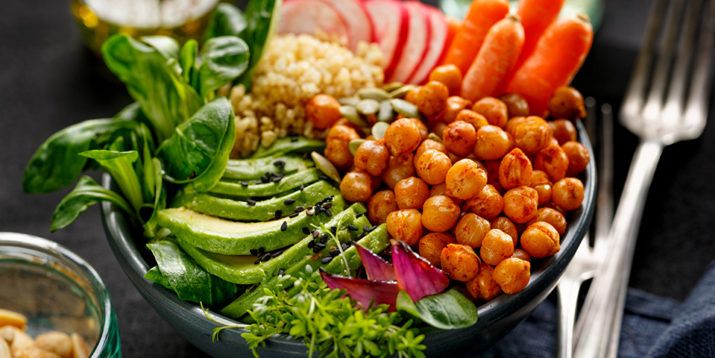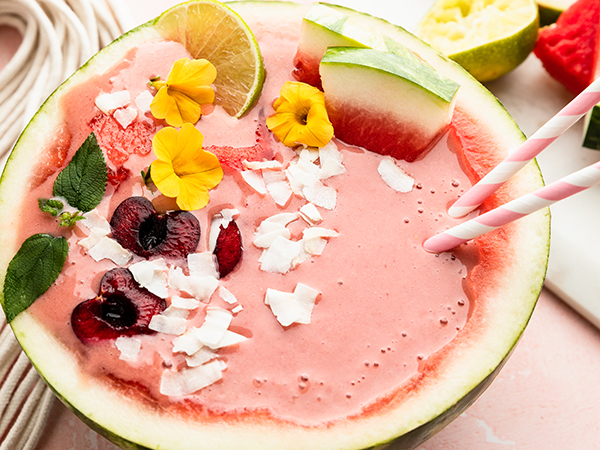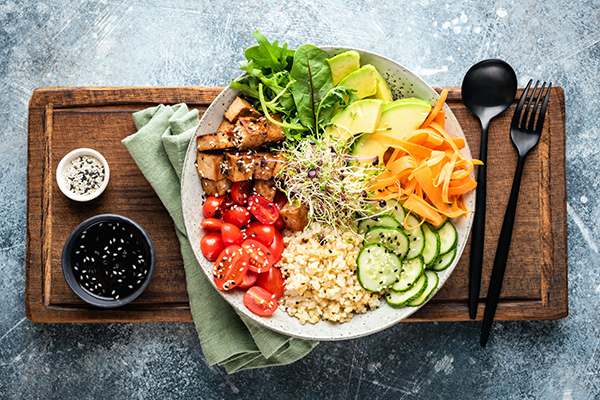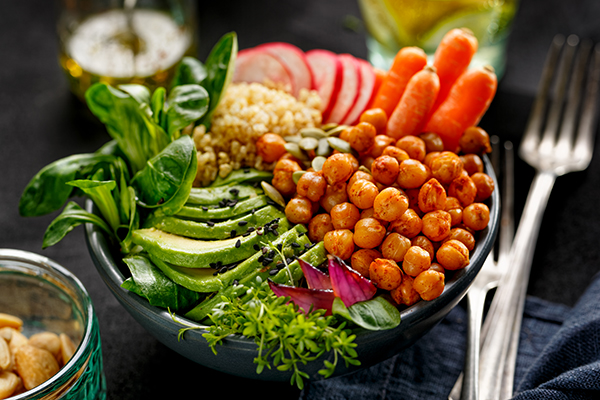How to Make a Protein Bowl for a Satisfying Meal

A protein bowl is a balanced meal piled into one colorful bowl. It looks so intentionally Instagram-worthy that no one would know you’re probably noshing on leftovers.
Protein bowls (also called protein power bowls) contain protein, grains, and vegetables.
They’re so easy to make — just throw everything in a bowl and mix it up!
It’s a convenient way to transform ingredients from batch cooking or leftovers into a new meal. You can also make vegan and vegetarian versions by swapping in plant-based proteins.
That’s why other names for protein bowl are Buddha bowl, grain bowl, or the Ayurvedic-inspired kitchari bowl.
Most protein bowls are a savory affair, but if you’ve got a sweet tooth, you can make a sweet version with protein powder, fruits, and a little imagination. A good example is our watermelon Bahama Smash Bowl.

Are protein bowls good for you? Can they help with weight loss? Absolutely!
The main ingredients in protein power bowls — lean protein, whole grains, and veggies — make for a very filling meal. Protein and fiber are two key nutrients known to help you feel fuller for longer.
OK, let’s get started! Here are five easy steps to make protein power bowls.
Note: The serving sizes suggested below for grains, proteins, fats, and sauces, depending on your weight gain or weight loss goals, and will vary individually.
Step 1: Stuff the base with veggies
Fill half the bowl with vegetables, cooked and uncooked.
Fresh veggies bulk up the bowl and add a refreshing crunch factor. Try favorites like:
- Leafy greens
- Spinach
- Arugula
- Chopped kale
- Carrots
- Radish
- Jicama
- Peppers
- Cucumbers
- Onions
Play around with different knife techniques such as matchstick, dice, chiffonade, or julienne to achieve a pretty power bowl.
Cooked veggies, particularly roasted ones, add more flavor to your power bowl. To get you started, try batch cooking any of these:
- Roasted Asparagus
- Roasted Butternut Squash
- Roasted Broccoli
- Roasted Rainbow Carrots
- Roasted Green Beans

Step 2: Go whole on the grains
“My favorite ingredients for power bowls are leftovers,” Holly McKee-Clark, culinary specialist for BODi.
“Leftover grains are great in these throw-together bowls for lunch. If I make quinoa or farro for a meal, I usually cook a little extra and store it separately in the fridge for when I inevitably want a power bowl. A half-cup for lunch is perfect. A nice serving of fiber plus a yummy chewiness in every bite.”
Other whole grains that work well include:
- Barley
- Brown rice
- Bulgar
- Couscous
Step 3: Pack it with lean protein
Getting enough lean protein can help with muscle building and repair. Shredded or chopped leftover chicken, beef, pork, and fish are a no-brainer addition to protein power bowls.
But what if you don’t have leftovers?
Try making a quick trip to the grocery store to pick up canned tuna, rotisserie chicken, or frozen chicken strips (try to make sure your choice is not breaded and doesn’t contain a lot of added salt).
Eggs, shrimp, and salmon are good options because they don’t take long to cook on your stovetop.
You can even make it plant-based and skip the meats altogether.
Says McKee Clark, “Beans pack a plant-based protein punch and are loaded with filling fiber, too. I always have a few cans of assorted beans on hand. A great protein serving size for a plant-based diet is ¾ cup. Four to six ounces of lightly sautéed tofu or tempeh goes great in a bowl, too.”

Step 4: Add toppings
Toppings give a protein bowl more variety. You can adjust it based on what’s available in your pantry. The options are endless but include:
- Nuts
- Seeds
- Chopped avocado
- Dried fruits
- Shredded cheese
If you’re making a plant-based power bowl, McKee-Clark highly recommends adding nuts.
“Although they’re higher in fat gram for gram than other proteins, it’s a healthy fat,” she says. “And adding a tablespoon of almonds, peanuts, or cashews will give you a few extra grams of crunchy protein. Opt for unsalted or raw, whenever possible.”
Step 5: Sauce it up
If you added seasoned and cooked proteins and veggies, the final layer of flavor comes from saucing up your protein bowl.
You don’t need to stick with just one sauce either. You can drizzle some citrus vinaigrette and then spoon some salsa into the bowl before mixing.
Or whip up some chimichurri sauce or Greek yogurt tzatziki to give your bowl more flair.
McKee-Clark’s tip for getting max flavor out of those bowls: “I. Love. Worcestershire sauce. It’s not just for steaks on the grill; it’s delicious everywhere. A splash in your vinaigrette will bring an indefinable umami flavor.”
“Beware: if you’re vegetarian, there is usually fish sauce in Worcestershire sauce. Get a Kosher version, which is vegan. If you’re starting with a thick dressing, you’ll be able to make your dressing spread even further with 1–2 tablespoons of water,” she adds.
Want more expert nutrition advice? Check out BODi Nutrition and learn how BODi nutrition programs and products can help you lead a healthier lifestyle.
